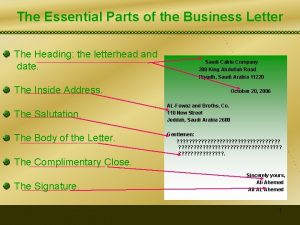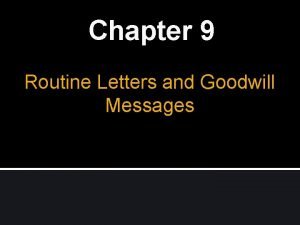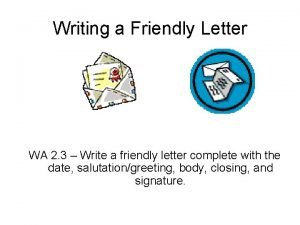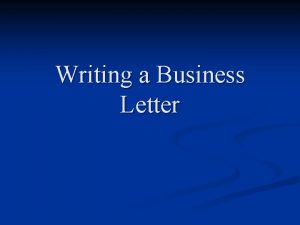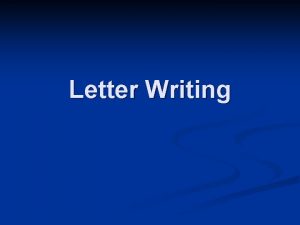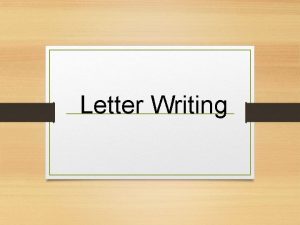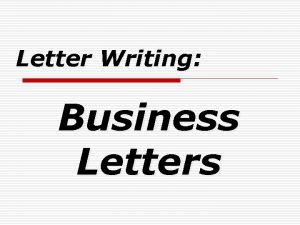LETTER WRITING TYPES ESSENTIAL PARTS Letters are messages












- Slides: 12

LETTER WRITING TYPES & ESSENTIAL PARTS

• Letters are messages. There are different kinds of letters. They are; • 1. Friendly Letters: • They are written to friends, relatives and acquaintances. • Their style is conversational style. • The language of such letters is simple, direct and natural. • Humorous touch also adds to the interest of the letter. • They have no strict rules of style and grammar.

• 2. Business Letters: • Written to shopkeepers, merchants, commercial firms, customers, dealers and manufacturers. • They are terse, clear and to the point. Businessmen have no time to read long, rambling and confused letters. • All business letters are considered formal in style. Abbreviation should be avoided as much as possible.

• 3. Social Letters: • Social Letters include invitation and replies, letters of congratulation, thank you notes and letters of condolence. • They are more formalin style. • They may be hand written or typed. Depending upon the relation-ship of the sender and recipient. • They are shorter than personal letters because they are intended for specific purpose.

The Form & Style of Business Letter • In a business letter form and style are as important as the contents. • There are different parts of business letters. • They are broadly divided into: • Essential Parts. • Optional parts.

ESSENTIAL PARTS • There are SIX essential parts of letters. • 1) The Heading: • It shows where the letter comes from. It consists of the name and full address of the firm and the date. It shows the readers where to reply. • The position of the heading is at the top right hand corner of the first page of the letter. The date is written two spaces below the address. The date should be written in full. There are different formats of writing dates; they are: • 10 -03 -2005 • 10 th of March, 2005 • Some companies use printed sheets on which the letterhead is printed at the top center of the letter. It includes all the information like address, telephone numbers of branch offices etc. {British Style} {American Style} 03/10/2005 {American Style} March 10, 2005 {American Style}

The Inside Address: • It includes the name and address of the person, group or organization to whom you are writing and it is written on the first page, lower down than heading at the left hand margin of the page. • The purpose of the inside address is to identify the receive of the letter. It serves three functions. • Identification for delivery by the receiver. • Serve as record for the sender. • Provide an additional address for the delivery to the addressee if the envelop is removed or damaged. • Punctuation is not necessary. • In the inside address thing come in the following order;

The Inside Address: • Courtesy Title: It comes first if the addressee has no professional title like Dr, Professor etc Mr. , Mrs. , Miss or Ms are used. • • b. After courtesy title, write the full name of the addressee. • • Name: c. Executive or Professional Title: Depending upon the length, it may be typed. • • In the same line with the name. • In the second line before address or organizations name. • A line or two by it self e. g. • I Mr. John Edward, Secretary II Mr. Ahmad Ali Rizvi • Ministry of Education, Greasurer, Gul and Company, • Park Avenue, Islamabad. Hayatabad, Peshawar.

SALUTATION: • It is a form of greeting, which depends upon the relation of the writer and the receiver. It is written two spaces below the inside addresses if attention line is not included. Conventionally the word “Dear” is placed before the name or title of the person. It use is purely formal and is just a polite expression. • Salutation is written at the left hand margin two spaces above the body of the letter e. g. • Dear Ali, Dear Father/Mother/etc to relatives • Dear Sir/Madam/Mr. Jehan Alam etc in business letters • Gentlemen, Ladies etc for group of people. • Colon is used after the salutation.

THE BODY: • This is actual letter or the message, which the writer wants to convey. The style of writing depends upon the relation of writer and receiver. We should consider the following hints while writing the body of letter. • It should be written in paragraphs. Lines should be single spaced but double space between paragraphs. • Use simple sentence structure. From short sentences in simple and clear language. Be straight forward as much as possible. • First think and than write logically arrange your ideas. Don’t forget the principles (7 C’s) of communication. • Write legibly and put punctuation marks at proper place.

SUBSCRIPTION OR COMPLEMENTARY CLOSE: • These are leave taking words. Its purpose is to express farewell at the end of the letter. It is written two spaced below the last line of the body and at the right hand margin of the page. Coma is used at the end of complementary close. The first word of subscription is capitalized. • Some polite expressions are: • Yours sincerely, yours obediently, cordially yours, yours faithfully, yours truly. • • In formal letter some additional phrases are used. Such as Warm Regards, Best Wishes etc

The Signature: • In letters to the strangers, the signature (the name of the writer) should be clearly written, so that reader may know whom to address in reply. • It is written three spaces below the complementary closes. • The signature are include: • Name of your company (optional) • Your signature. • Your type written name • Your professional title (optional) • Example are given below • I Sincerely yours II Sincerely yours • Arif Khan Tufail Ahmad Faraz • Lecturer Qurtuba University Scientific Assistant, PCSIR Labs.
 Mikael ferm
Mikael ferm Sky letters
Sky letters Mailing notation in business letter
Mailing notation in business letter What is a routine letter
What is a routine letter Examples of goodwill messages
Examples of goodwill messages Short goodwill messages
Short goodwill messages Essential non essential fatty acids
Essential non essential fatty acids Optional element in business letter
Optional element in business letter Friendly business letter format
Friendly business letter format Body of a friendly letter
Body of a friendly letter Typist initials on business letter
Typist initials on business letter Business letter parts
Business letter parts Modified style business letter
Modified style business letter


